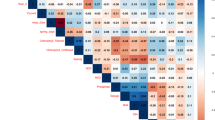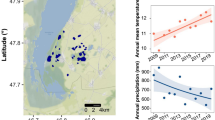Abstract
One of the fastest rates of recent climate warming has been reported for the Arctic and the maritime Antarctic1; for example, mean annual temperatures increased by 0.5 °C per decade over the Antarctic Peninsula during the past 50 years2. Owing to their comparatively simple and highly sensitive food webs3, polar freshwater systems, with cyanobacterial mats representing the dominant benthic primary producers4, seem well suited for monitoring environmental perturbation, including climate change5. Prolonged climate change may challenge the resilience, plasticity and adaptability and thus affect the community composition of cyanobacterial mats. We demonstrate that exposing polar mat samples to raised temperatures for six months results in a change in species predominance. Mats exposed to a constant temperature of 8 °C or 16 °C showed high cyanobacterial diversity, commensurate with an increased presence of cyanobacterial toxins. In contrast, mats held at 4 °C and 23 °C seemed low in diversity. Our data thus indicate that a temperature shift to 8–16 °C, potentially reached during summer months in polar regions at the present warming rate, could affect cyanobacterial diversity, and in some instances result in a shift to toxin-producing species or to elevated toxin concentrations by pre-existing species that could profoundly alter freshwater polar ecosystems.
This is a preview of subscription content, access via your institution
Access options
Subscribe to this journal
Receive 12 print issues and online access
$209.00 per year
only $17.42 per issue
Buy this article
- Purchase on Springer Link
- Instant access to full article PDF
Prices may be subject to local taxes which are calculated during checkout




Similar content being viewed by others

References
Trenberth, K. E. et al. in IPCC Climate Change 2007: The Physical Science Basis (eds Soloman, S. et al.) (Cambridge Univ. Press, 2007).
Turner, J. et al. Antarctic climate change during the last 50 years. Int. J. Climatol. 25, 279–294 (2005).
Camacho, A. Planktonic microbial assemblages and the potential effects of metazooplankton predation on the food web of lakes from the maritime Antarctica and sub-Antarctic islands. Rev. Environ. Sci. Bio/Technol. 5, 167–185 (2006).
Vincent, W. F. in The Ecology of Cyanobacteria, their Diversity in Time and Space (eds Whitton, B. A. & Potts, M.) 321–340 (Kluwer Academic Publishers, 2000).
Quayle, W. C., Peck, L. S., Peat, H., Ellis-Evans, J. C. & Harrigan, P. R. Extreme responses to climate change in Antarctic lakes. Science 295, 645 (2002).
Quesada, A., Fernández-Valiente, E., Hawes, I. & Howard-Williams, C. Polar Lakes and Rivers Limnology Of Arctic and Antarctic Ecosystems (Oxford Univ. Press, 2008).
de los Rios, A., Ascaso, C., Wierzchos, J., Fernández-Valiente, E. & Quesada, A. Microstructural characterization of cyanobacterial mats from the McMurdo Ice Shelf, Antarctica. Appl. Environ. Microbiol. 70, 569–580 (2004).
Cary, S. C., McDonald, I. R., Barrett, J. E. & Cowan, D. A. On the rocks: The microbiology of Antarctic Dry Valley soils. Nature Rev. Microbiol. 8, 129–138 (2010).
Hitzfeld, B. C. et al. Toxin production in cyanobacterial mats from ponds on the McMurdo Ice Shelf, Antarctica. Toxicon 38, 1731–1748 (2000).
Chorus, I. & Bartram, J. Toxic Cyanobacteria in Water: A Guide to their Public Health Consequences, Monitoring and Management (E&FN Spon, 1999).
Convey, P. Trends In Antarctic Terrestrial And Limnetic Ecosystems (Springer, 2006).
Pearce, D. A. The structure and stability of the bacterioplankton community in Antarctic freshwater lakes, subject to extremely rapid environmental change. FEMS Microbiol. Ecol. 53, 61–72 (2005).
Yergeau, E., Newsham, K. K., Pearce, D. A. & Kowalchuk, G. A. Patterns of bacterial diversity across a range of Antarctic terrestrial habitats. Environ. Microbiol. 9, 2670–2682 (2007).
Vincent, W. F. Microbial ecosystem responses to rapid climate change in the Arctic. ISME J. 4, 1089–1091 (2010).
Velázquez, D., Rochera, C., Camacho, A. & Quesada, A. Temperature effects on carbon and nitrogen metabolism in some Maritime Antarctic freshwater phototrophic communities. Polar Biol. 34, 1045–1055 (2011).
Pringault, O., Buffan-Dubau, E. & Wit, R. D. Artificial cold-adapted microbial mats cultured from Antarctic lake samples. 2. Short-term temperature effects on oxygen turn-over. Aquatic Microbiol. Ecol. 26, 127–138 (2001).
Ginn, H. P., Pearson, L. A. & Neilan, B. A. NtcA from Microcystis aeruginosa PCC 7806 is autoregulatory and binds to the microcystin promoter. Appl. Environ. Microbiol. 76, 4362–4368 (2010).
Lürling, M. Effects of microcystin-free and microcystin-containing strains of the cyanobacterium Microcystis aeruginosa on growth of the grazer Daphnia Magna. Environ. Toxicol. 18, 202–210 (2003).
Dittmann, E. et al. Altered expression of two light-dependent genes in a microcystin-lacking mutant of Microcystis aeruginosa PCC 7806. Microbiology 147, 3113–3119 (2001).
Barrett, J. E. et al. Biogeochemical stoichiometry of Antarctic Dry Valley ecosystems. J. Geophys. Res. 112, 1–12 (2007).
Boyer, S. L., Flechtner, V. R. & Johansen, J. R. Is the 16S–23S rRNA internal transcribed spacer region a good tool for use in molecular systematics and population genetics? A case study in cyanobacteria. Mol. Biol. Evol. 18, 1057–1069 (2001).
Vincent, W. F. & Howard-Williams, C. Microbial communities in southern Victoria Land streams (Antarctica) II. The effects of low temperature. Hydrobiologia 172, 39–49 (1989).
Upton, A. C., Nedwell, D. B. & Wynn-williams, D. D. The selection of microbial communities by constant or fluctuating temperatures. FEMS Microbiol. Lett. 74, 243–252 (1990).
Wood, S. A., Rueckert, A., Hamilton, D. P., Cary, S. C. & Dietrich, D. R. Switching toxin production on and off: Intermittent microcystin synthesis in a Microcystis bloom. Environ. Microbiol. Rep. 3, 118–124 (2011).
Stanier, R. Y., Kunisawa, R., Mandel, M. & Cohenbazire, G. Purification and properties of unicellular blue-green algae (order Chroococcales). Bacteriol. Rev. 35, 171–205 (1971).
Wood, S. A., Rueckert, A., Cowan, D. A. & Cary, S. C. Sources of edaphic cyanobacterial diversity in the Dry Valleys of Eastern Antarctica. ISME J. 2, 308–320 (2008).
Saker, M. L., Jungblut, A. D., Neilan, B. A., Rawn, D. F. K. & Vasconcelos, V. M. Detection of microcystin synthetase genes in health food supplements containing the freshwater cyanobacterium Aphanizomenon flos-aquae. Toxicon 46, 555–562 (2005).
Pruesse, E. et al. SILVA: A comprehensive online resource for quality checked and aligned ribosomal RNA sequence data compatible with ARB. Nucleic Acids Res. 35, 7188–7196 (2007).
Frickey, T. & Lupas, A. CLANS: A Java application for visualizing protein families based on pairwise similarity. Bioinformatics 20, 3702–3704 (2004).
Altschul, S. Gapped BLAST and PSI-BLAST: A new generation of protein database search programs. Nucleic Acids Res. 25, 3389–3402 (1997).
Acknowledgements
For financial support of the Antarctic expedition we would like to acknowledge the Deutsche Forschungsgemeinschaft (DFG)-funded project DI698/18-1 Dietrich, as well as the Spanish Ministry of Science and Technology through project LIMNOPOLAR (POL2006–06635 and CGL2005-06549-C02-01/ANT to A.Q., as well as CGL2005-06549-C02-02/ANT to A.C., the last of these co-financed by European FEDER funds). We thank the TOTAL Foundation for funding the expedition to Baffin Island and within this context O. Dargent, Nice, France, and P. van West, University of Aberdeen, UK, for collecting and photographing Arctic specimens on Baffin Island. We would also like to thank the Carl Zeiss Stiftung and the Excellence Initiative of the University of Konstanz, Germany, for funding the PhD project of J.K. and APECS for their support to conference contributions. Furthermore, we acknowledge the support of the European Community research infrastructure action under the FP7 ‘capacities’ specific programme ASSEMBLE No.227788. For technical support and new ideas we are very grateful to D. Schleheck, H. Bastek and K. Leinweber from the University of Konstanz, Germany, and A. Jungblut from the Natural History Museum, London, UK.
Author information
Authors and Affiliations
Contributions
J.K. planned and carried out all presented experiments, and prepared the data, figures and the manuscript. S.A.W. assisted in experimental procedures and analysed the ARISA samples. F.C.K. organized and collected the samples of the Arctic expedition. A.Q. and A.C. were in charge of the organization and collected the samples during the Antarctic expedition. T.F. carried out the bioinformatic analysis of sequence data. D.R.D. was the project coordinator, supervisor of experiments, planned and carried out some experiments and prepared the manuscript. All authors contributed equally to critically reviewing the manuscript and discussing experiments and results.
Corresponding author
Ethics declarations
Competing interests
The authors declare no competing financial interests.
Supplementary information
Rights and permissions
About this article
Cite this article
Kleinteich, J., Wood, S., Küpper, F. et al. Temperature-related changes in polar cyanobacterial mat diversity and toxin production. Nature Clim Change 2, 356–360 (2012). https://doi.org/10.1038/nclimate1418
Received:
Accepted:
Published:
Issue Date:
DOI: https://doi.org/10.1038/nclimate1418
This article is cited by
-
Prokaryotic diversity and biogeochemical characteristics of benthic microbial ecosystems from James Ross Archipelago (West Antarctica)
Polar Biology (2022)
-
The toxic cosmopolitan cyanobacteria Moorena producens: insights into distribution, ecophysiology and toxicity
Environmental Science and Pollution Research (2022)
-
Atmospheric CO2 availability induces varying responses in net photosynthesis, toxin production and N2 fixation rates in heterocystous filamentous Cyanobacteria (Nostoc and Nodularia)
Aquatic Sciences (2021)
-
The structure and toxicity of winter cyanobacterial bloom in a eutrophic lake of the temperate zone
Ecotoxicology (2018)
-
Effects of temperature on extracellular hydrolase enzymes from soil microfungi
Polar Biology (2018)


